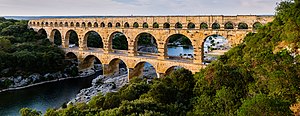
Back قناة رومانية Arabic रोमन एक्वाडक्ट Bihari Aqüeducte romà Catalan Římské akvadukty Czech Romersk akvædukt Danish Wasserversorgung im Römischen Reich German Romia akvedukto Esperanto Acueducto romano Spanish آباره رومی Persian Rimski akvadukt Croatian

The Romans constructed aqueducts throughout their Republic and later Empire, to bring water from outside sources into cities and towns. Aqueduct water supplied public baths, latrines, fountains, and private households; it also supported mining operations, milling, farms, and gardens.
Aqueducts moved water through gravity alone, along a slight overall downward gradient within conduits of stone, brick, concrete or lead; the steeper the gradient, the faster the flow. Most conduits were buried beneath the ground and followed the contours of the terrain; obstructing peaks were circumvented or, less often, tunneled through. Where valleys or lowlands intervened, the conduit was carried on bridgework, or its contents fed into high-pressure lead, ceramic, or stone pipes and siphoned across. Most aqueduct systems included sedimentation tanks, which helped to reduce any water-borne debris. Sluices, castella aquae (distribution tanks) and stopcocks regulated the supply to individual destinations, and fresh overflow water could be temporarily stored in cisterns.
Aqueducts and their contents were protected by law and custom. The supply to public fountains took priority over the supply to public baths, and both took priority over supplies to wealthier, fee-paying private users. Some of the wealthiest citizens were given the right to a free supply, as a state honour. In cities and towns, clean run-off water from aqueducts supported high consumption industries such as fulling and dyeing, and industries that employed water but consumed almost none, such as milling. Used water and water surpluses fed ornamental and market gardens, and scoured the drains and public sewers. Unlicensed rural diversion of aqueduct water for agriculture was common during the growing season, but was seldom prosecuted as it helped keep food prices low; agriculture was the core of Rome's economy and wealth.[1]
Rome's first aqueduct was built in 312 BC, and supplied a water fountain at the city's cattle market. By the 3rd century AD, the city had eleven aqueducts, sustaining a population of over a million in a water-extravagant economy; most of the water supplied the city's many public baths. Cities and towns throughout the Roman Empire emulated this model, and funded aqueducts as objects of public interest and civic pride, "an expensive yet necessary luxury to which all could, and did, aspire".[2] Most Roman aqueducts proved reliable and durable; some were maintained into the early modern era, and a few are still partly in use. Methods of aqueduct surveying and construction are noted by Vitruvius in his work De architectura (1st century BC). The general Frontinus gives more detail in his official report on the problems, uses and abuses of Imperial Rome's public water supply. Notable examples of aqueduct architecture include the supporting piers of the Aqueduct of Segovia, and the aqueduct-fed cisterns of Constantinople.
© MMXXIII Rich X Search. We shall prevail. All rights reserved. Rich X Search